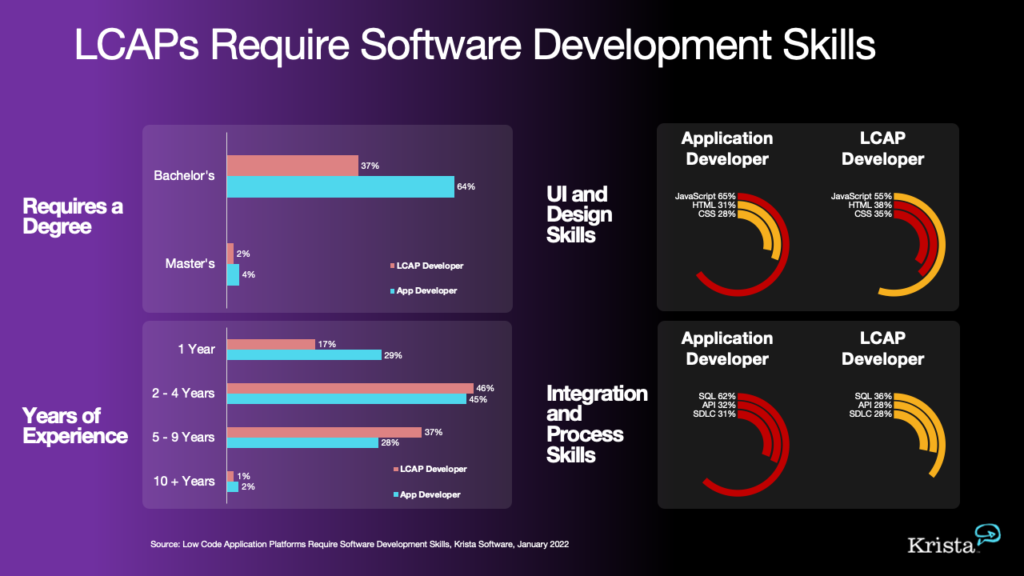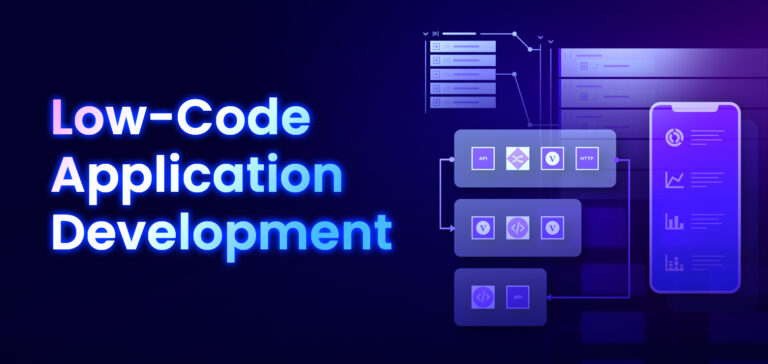Top News For Deciding On Low-Code Platform Examples
Wiki Article
The Accessibility Of Low-Code Applications Is Among The Major Advantages.
Due to a number of factors the development of low-code applications is easier for non-developers. These are sometimes referred to as "citizens developers."
Drag-and-drop Builders: Lowcode platforms include drag-anddrop interfaces to let non-developers create visual applications, without having to codes. This makes the development process easier for those with no technical background.
WYSIWYG editor: The "What you see is the result you will get" editors allow users to create interfaces, workflows, and other features in a manner that closely mimics the final result. They are easy to learn and utilize.
Simple Logic and Workflow:
Visual Workflow Modeling: Users can create business procedures and logic for applications using visual flowcharts or models. This is more simple than traditional programming methods.
Low-code platforms typically have pre-built logic elements (e.g., conditional statements loops, conditional statements) which can be easily set up, reducing the requirement for complicated coding.
Reusable Components & Templates
Libraries of prebuilt templates Low-code platforms usually provide templates libraries for popular application types. This gives non-programmers the possibility of starting with a solid base and modify it as needed.
Reusable Modules and Widgets: Users can leverage reusable widgets and modules, streamlining the creation process and reducing the need for in-depth technical knowledge.
Guided Development and Tutorials
Step-by -Step Instructions: Platforms usually provide tutorials that are on screen, guided development paths and other tools that help non-developers create applications.
Interactive Tutorials: Interactive, hands-on tutorials help users learn by doing, increasing their knowledge and confidence making use of the platform.
Integration with Existing Tool:
Seamless Integrate: Low code platforms are built to integrate seamlessly with the existing systems and tools within business (e.g. the ERP or CRM) This lets non-developers to develop applications that work with current workflows.
APIs Connectors: APIs are built into applications to make integration easier. This allows non-developers, who do not have coding abilities, to connect to external services.
Collaboration Features:
Team Collaboration: Features such as real-time collaboration, as well as shared workspaces let non-developers to work alongside professional developers, business analysts and other stakeholders efficiently.
Access Control Based on Roles: Non-developers are able to have access to roles and levels of access that permit them to contribute without compromising security or functionality.
Automated Tests and Debugging
Low-code platforms usually come with integrated testing and debugging tool that simplifies the process. Developers who are not developers can now verify that their app is working correctly.
Platform identifies errors as they happen and suggests solutions. This assists non-developers in solving problems.
The main benefit of developing applications using low-code for accessibility to non-developers comes due to its ability to decentralize the development process. Low-code platforms are easy to use, visual tools, guided experiences and enable business users actively participate in creating updates, maintaining and enhancing applications. Have a look at the top rated Low-code Platform for application development for website advice including driver jdbc, software for app development, rad application development, rad application development, software for app development, azure sql server, low code development platforms, mobile development platforms, sso azure, driver jdbc and more.

Scalability And Flexibility Are Two Benefits Of Low Code Application Development
Low-code app development provides several advantages, including scaling and a flexible design for the application. These are essential to create applications that respond to changing requirements and evolve with the company. Here are some of the key advantages.
Cloud-based Deployment. Many low-code platforms feature a cloud-based implementation, which allows them to scale applications seamlessly by using cloud infrastructure. This allows businesses to manage the increasing demands without worry about server management.
Auto-Scaling Features: Auto-scaling capabilities built into the system will automatically adjust resources in response to demand, ensuring constant performance during peak times without manual intervention.
Flexible Architecture:
Modular Design: Low code platforms encourage the modular design of applications, which allows components to be independently designed developed, tested and scaleable. This modularity improves flexibility and enables easier upgrades or expansions of certain parts without impacting the whole system.
Microservices Architecture: Microservices architecture allows the creation of applications as an loosely coupled collection of services. This improves the flexibility and scalability.
Customizable Solutions
Extensibility. Low-code platforms usually allow the creation of custom scripts or coding. This enables developers to enhance the capabilities of the software beyond what is offered from the box. This guarantees that specific requirements of business can be met without a limit.
Third-Party Integrations: The incorporation of APIs, third-party services or other services allows businesses to increase the capabilities of their application by adding additional functionalities.
Agile Development & Deployment
Continuous Delivery and Deployment Low-code platforms can be used to implement agile methods which allow continuous integration as well as continuous delivery (CI/CD). This lets applications be updated and upgraded quickly, in response with user feedback.
Iterative Development - The low-code method allows applications to be improved and scaled incrementally which reduces risk and allows for more controlled growth.
Resource Optimization:
Effective Resource Management: Low-code platforms allow you to maximize the use of resources by offering tools to monitor and manage the performance of applications. This makes sure that resources are used efficiently and are easily scaled to meet the actual demands.
Load Balancing: The integrated load balancing feature divides the workload evenly among servers. This increases the application's capacity to handle the demands of high traffic and also ensures consistent performance.
Global Reach
Multi-Region deployment: Low-code systems can often support deployment across multiple regions. This allows businesses to provide low-latency services to users from all over the world. This is particularly important for applications which have users across the globe.
Support for Localization: The built-in support of localization allows the applications to be easily customized to suit various languages and needs in diverse markets.
Maintenance and Updates
Maintenance is simplified because of the modularity and appearance of low-code applications makes maintenance easier which allows quick fixes and updates to be implemented without lengthy downtime.
Version Control: Integrated versions control systems permit the secure deployment of updates and rollbacks. Older versions can be restored if they're needed.
Cost Efficiency:
Low Development Costs - Through cutting down on the amount of code needed, low-code platforms can cut down on the development cost. This allows you to increase the size of applications without needing to increase development efforts and expenses.
Pay-As You-Go Models - Many low-code applications have flexible pricing models such as pay-as-you-go, which adjusts prices to the actual usage, growth, as well as financial flexibility.
Overall the scalability, flexibility and scalability advantages of low-code applications enable businesses to build robust, adaptable and scalable apps efficiently. These platforms enable rapid changes to meet changing demands as well as efficient utilization of resources and continual improvement. Applications can evolve and change with the business. Read the recommended Enterprise application development with Low-code Platform recommendations for site tips including rapid applications, low code development platforms, low code development platforms, lowcode no code, push notifications, application development platforms, application modernisation, cross platform mobile app development, application modernization, rapid app development and more.

Support From Vendors And Community Are Two Of The Advantages Of Low Code Application Development.
Low-code development platforms for applications provide significant advantages in terms of the support provided by vendors and communities, which are essential for successful implementation, ongoing maintenance and constant enhancement of applications. These are the main benefits: Support
Comprehensive Technical Support:
Dedicated Support Team: Many low code platforms have dedicated support staff who are available to help with technical queries in troubleshooting and assistance. They can ensure that issues are resolved quickly.
Some vendors offer 24/7 support. This is particularly beneficial to global businesses with different time zones.
Training and Onboarding
The structured training programs offered by vendors offer structured courses like webinars or courses for certification. This allows users to quickly get to grips with the platform.
Personalized onboarding: Many companies offer tailored services for new customers, to help them implement the platform correctly and tailor it to suit their requirements.
Regular updates and enhancements
Continuous improvement: Low-code platform providers generally release periodic updates which contain the latest features, performance improvements as well as security patches, making sure that their platform is up-to-date and safe.
Feedback Integration: Vendors integrate feedback from their users into their development cycles to ensure that the platform is constantly evolving to meet the ever-changing needs of its users.
Comprehensive Documentation:
The Documentation In Detail Users will find solutions to their issues by reading the detailed and well-organized manual that covers all aspects of the software beginning with its fundamental functionality to more sophisticated customisation.
API References Comprehensive API documentation enables developers to modify applications and connect low-code platforms into other platforms.
Consulting and Professional Services:
Expert Consultation : Vendors offer consulting services, such as the design of architectures and complicated implementations. They provide this service to ensure that users are able to take full advantage of the platform.
Custom Development Services Some vendors offer customized development services to help with specific capabilities or integrations that are not offered from the standard version.
Community Support for the Community
Active User Groups:
Discussion boards and forums: Many platforms with low-code offer a lively online community for users to ask for help, share solutions, and work together to discover the best techniques.
Local and Virtual User Groups and Meetups provide the opportunity for users to exchange experiences, gain knowledge from other users, and connect with.
Knowledge Sharing and collaboration:
Community-Contributed Resources: Users often share templates, modules, and extensions that they have developed, which can be reused or adapted by others, accelerating development and innovation.
Crowdsourced Solution Finding: The collective experience and wisdom of a community can be a great resource for finding solutions to complex problems.
Learning and Development
Community-Led training: Many communities provide webinars, workshops, and training sessions that are led by knowledgeable users.
Online Tutorials and Courses Community members usually create and distribute online tutorials, courses, and how-to guide, improving the learning resources for all users.
Feedback and Influence
Community Forums are often an opportunity for vendors to receive feedback from the community. This information can be used to create new features or improve the functionality of.
Beta Testing Programs Members of the community who are active may have the opportunity of participating in beta programs. This gives them an early view on the latest features, as well as the chance to influence the evolution of the platform.
Recognition and support:
Community Recognition Programs: A lot of vendors offer recognition programs to recognize the contribution of community members who are active for example, MVP (Most Valuable Professional) programs.
Peer Support: Community members give support to each other by sharing their experiences and providing advice. They help create a cooperative and supportive environment by sharing knowledge.
Overall, the combination of a solid vendor with active and engaged communities. They provide an extensive environment to assistance with low-code development of applications. Users will have the ability to gain access to the experts, resources and collaboration opportunities they require to build and deploy, manage and further enhance their apps.
